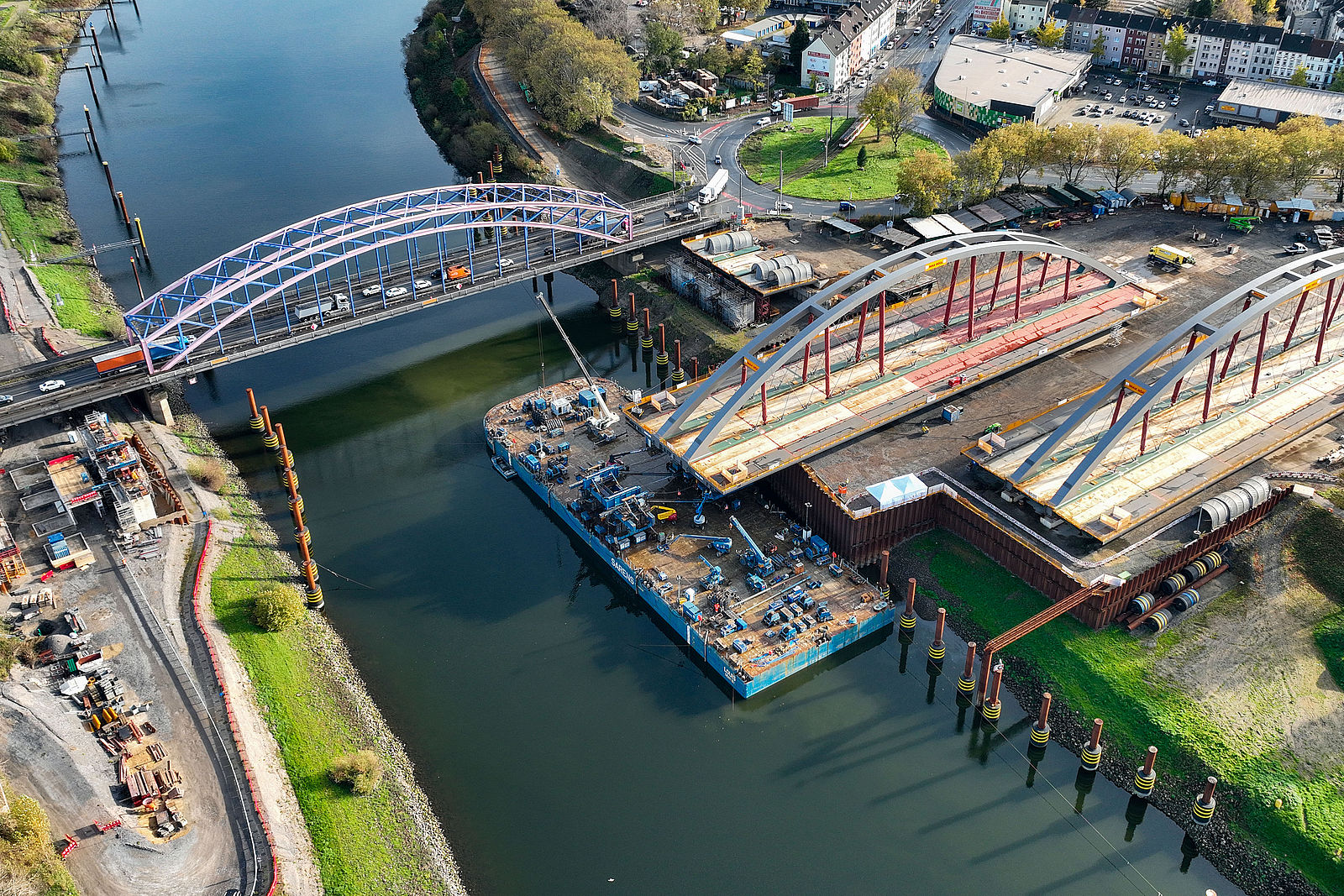
For bridge installations that demand flawless and safe execution, clients trust Sarens’ years of industry-tested wisdom and innovative engineering leadership. That is why, from the fall through winter of 2022, client Max Bögl asked Sarens to carefully install two vital bridges in the city of Duisburg: the Oberbürgermeister Karl Lehr Brücke (OBKL) over the Ruhr river, and the Hafenkanalbrücke spanning the canal that leads to the port of Duisburg.
The OBKL bridge is one of only three inner-city north-south connections across the Ruhr, an important axis for traffic, and the main artery for the port of Duisburg and associated logistical traffic. It is so vital to the city’s daily functioning that without it, officials say, traffic would be gridlocked, the port would be deprived of its primary road access, and normal traffic flow as well as local public transport would come to a standstill. “Duisburg is simply unimaginable without this traffic axis,” they explain.
The new OBKL bridge to be installed, a massive 4.400-tonne structure of pure steel, measured 25 metres high, 34 metres wide, and 180 metres long including the approach bridges. It would replace the old structure connecting the Kaßlerfelder roundabout with the Pontwert.
The other bridge Sarens was tasked with installing, the new Hafenkanalbrücke, weighed approximately 3.650 tonnes and was also constructed of pure steel. It measured 25 metres high, 34 metres wide, and 126 metres long. It would replace the old structure connecting the Pontwert to Mercator Island.
The challenge
This particular operation posed significant challenges, not the least of which was skidding heavy bridge sections within a limited operational window that left no room for error. There was limited space to set up equipment for the operation. The crew also had to adjust to wind restrictions and very low water levels.
The solution
Sarens decided to use a combination of techniques and equipment, deploying a barge, SPMTs, strand jacks, skidding systems, and various climbing systems to safely install both bridges. The engineering team worked out all the calculations and drawings to skid the heavy bridge sections into place, despite low water levels.
After numerous calculations and meticulous planning, the team shortlisted the following equipment:
Barge Paula (100m x 33m x 7,6m)
68 axle-lines SPMTs
12 x SJ200T strand jacks
8 x CS450 jacking system
16 x CS250T jacking system
Modular beam system, 1500mm x 1000mm
Bracing systems
Skidding system
All equipment was set up within six weeks, and everything except the barge was transported via 75 truckloads from Sarens headquarters and various yards in Europe. The barge Paula was transported by tugboats over the North Sea and the River Rhine. The team also had to find solutions for bringing the strand jack cables over the water, using 12km of strands for the job.
Preparation
Sarens first conducted preparation and testing before transporting the bridges into position. The steel bridge parts were delivered by ship by client Max Bögl, and then assembled into bridge structures on the pre-assembly area next to the distribution circuit. When the assembly of both bridge superstructures was complete, they could then be partially loaded onto Sarens SPMTs and skidded over the floating barge Paula.
The operation
The Hafenkanalbrücke was the first bridge to be installed. The crew carefully skidded the bridge section, using strandjacks and skidshoes, onto the barge Paula. Next, the loaded barge was moved approximately 100 metres further with winch cables so that the bridge could be skidded over the barge on skidshoes installed on the island. The crew skidded the whole bridge over the island and parked it there, between the Rhine and the port canal.
In the meantime, the barge sailed around to the port canal, where the crew skidded the bridge back onto the barge via strandjacks and a skidding system. Once it was completely loaded, winch cables moved it into its final position. The bridge was then lowered onto the abutments by means of a jacking system.
Next, the barge Paula moved back to the Rhine to skid the OBKL bridge onboard in a similar manner. The bridge was then positioned by means of winch cables and lowered onto the abutments with a jacking system.
The team had to skid both bridges into place within a limited timeframe, in a very complex and difficult operation. To ensure safety throughout, the crew handled the extremely heavy bridge sections in a very slow and precise manner. Wind and water level restrictions further compounded this challenge, and the crew had to closely monitor the barge to ensure stability of the entire set-up given the low water levels and bridge sections to be installed.
The two bridges are currently floating in their temporary bypass position and will replace the old bridges once they are dismantled. Sarens is thrilled to celebrate the successful completion of yet another complex bridge installation project and would like to thank everybody who was involved in making it possible!